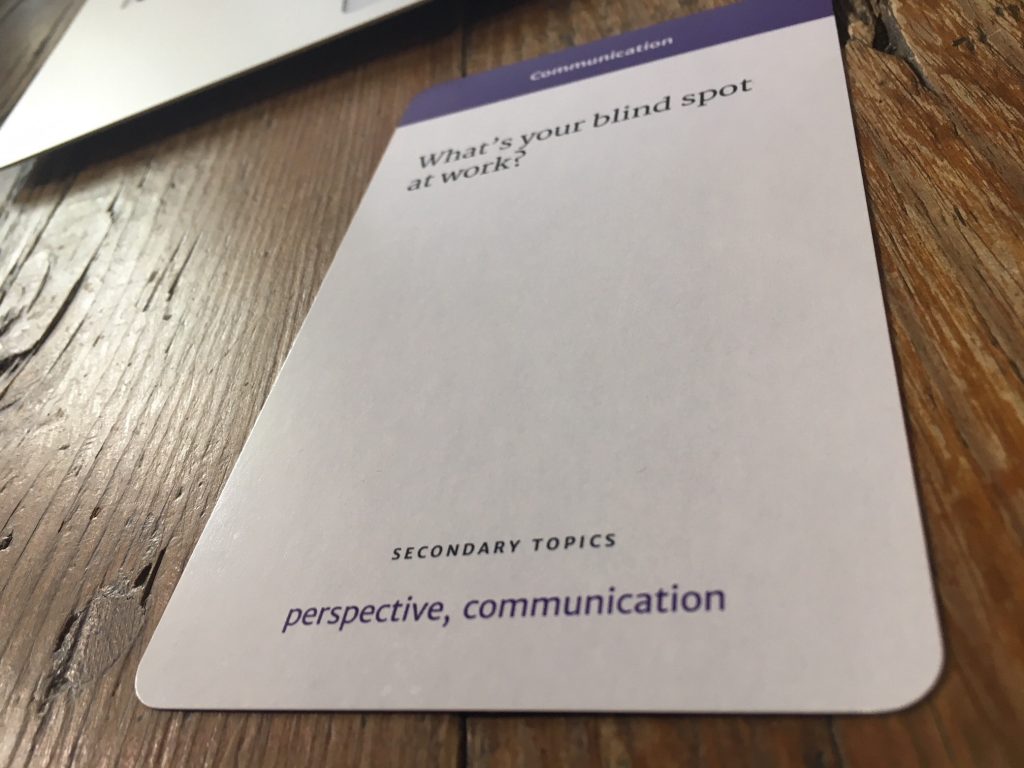
tldr; Plucky sells two 1:1 packs to help managers get more out of their meetings. Read more here or purchase your pack here.
So you bought the cards and now they’re sitting on your desk looking…. daunting. Your next round of 1:1s starts in a few minutes and you’d like to test drive these things. How do you begin?
There are tons of opportunities, but here are a few basic ways into the cards:
- You intentionally choose one card to use in all 1:1s this week, highlighting a question that feels relevant to your team. Maybe you post the question ahead of time so the team has time to ponder OR you launch it spontaneously in each session.
- You randomly choose one card to use in all 1:1s this week. You’re into experimenting but still want an anchor, of sorts.
- You fan out the cards at the beginning of a 1:1 and let your report pull a card. (If you manage a distributed team, fan a few up to the screen and ask them to choose from afar!)
- You use the cards in a group setting, perhaps to open a Monday morning meeting, kick off a client engagement or provoke discussion over lunch during your team offsite. The cards allow folks in the room to know each other differently — and set a new tone, rather than “business as usual.”
I say this all the time to clients and now I say it to you here: LIFE IS A GIANT SCIENCE EXPERIMENT. Try something! And then when it crashes and burns, try something else! (If it goes really embarrassingly poor, write to me because I would love to laugh with you about it.) There is no perfect way to use these cards because these cards are not the point of your conversation. Do you know what IS?
Building trust. Finding opportunities. These are the double majors of any good manager, the grounding principles that your role must embrace. In order to build trust, you must be able to talk about deeper issues than budgets and deadlines. In order to find opportunities, you must have insight into what — and who — you are hunting for.
Bring on the meeting!
Maybe now you’re feeling ready, excited even. Good, I love this enthusiasm. But let me make a suggestion: don’t start the 1:1 with the card.
These cards are powerful opportunities for connection, but they include Big Questions. And if you’ve got a report wandering in, fresh from an exhausting morning of meetings, you cannot drop this and expect it to land well.
Like with exercise, you gotta stretch first, warm up the conversation. Take a few minutes to talk nuts and bolts. What’s on fire lately? How is that issue you discussed last time? Share some feedback, receive some feedback, communicate Official Company Stuff, as-needed.
Then you can raise an eyebrow. “Do you want to try a card?” you ask. Try to look a little excited; some reports may be skeptical.
Explain why you got the cards, how managing is sometimes awesome and sometimes messy and authentically communicate that you are still learning, too.

Bring on the card!
However you got there, there is now a card on the table in front of you. Ask the question and wait for a response. Based on my many hours spent coaching humans, I see 3 main possibilities at this point:
- Your report is JAZZED. They start a lively conversation in which they laugh, draw you in, uncover fascinating themes about work and you both riff on them until the 1:1 closes. Cheers!
- Your report is unsure. What’s your blind spot at work? “I can’t think of anything…” or “I don’t understand the question.” DO NOT PANIC. Your report is telling you that they feel uncomfortable talking about themself in this moment. Jump in with your own interpretation of the card to model how to interact with this question. “I think what it’s asking is…” or “Hm, well for me I think I’d say…” Your perspective and willingness to share may loosen up something and invite your report to start talking.
- Your report is a robot. They have a Hemingway answer, by which I mean it is about 5 words long without any details. What’s your blind spot at work? “Predicting what the PMs want.” Any details to share? “It’s pretty self-explanatory.” Awkwardness fills the room. Somehow this 1:1 has become a stand-off in which you are pandering for adjectives, doubting your entire career in management. Chillax, friend. I got you.
Secondary Topics, to the rescue!
When I made the 1:1 Starter Pack, I knew you would end up here. For many reasons, humans can get stubborn and unwilling to throw you a bone. Lower your eyes to the Secondary Topics at the bottom of each card.
Secondary Topics is my chance to be your coach, to whisper in your ear. Psst! What you’re really listening for are these concepts! Drive the conversation here!
Let’s look at an example.

When you ask about blind spots, it requires your report to imagine something they do not normally think about. (That’s why it’s a blind spot!) You are trying to get them to shift perspective, to try on a few hats. They’re knocking it out of the park on this one project… but what about the one that’s been dragging along for a few months? How has that fallen by the wayside?
Equally, communication is relevant here. Sometimes blind spots get cleaned up by communicating more often or with different folks. How might they check in with different team members to make sure the project doesn’t fall off their radar again? Who should they be spending time with this week to refocus?
The card’s question is the launching topic. But there are always two other topics that you can fall back on to ask different angles of the question, additional opportunities to get anything out of the robots on your team.
Wrapping up
Regardless of how the card worked out, your 1:1 is coming to a close. Keep an eye on time and use the last few minutes to gracefully close your time together. Some of these cards are launching truly vulnerable topics — and if you shove a report out the door in the middle of a story about their father’s disappointment in blind spots, you are wounding the trust you just built.
Manage your time. Thank your report for sharing and for trying out a new way of talking. Invite them to think more about the question and to report back next time.
Then put the cards back in the box and sit quietly for a moment before your next meeting. You just did something bold. You attempted something new and risky.
And for that, dear manager, I want you to feel my high-five from afar. You are doing it. You are growing.
Keep. Going.
Want to hear more from me about the way we work? Sign up for Plucky’s monthly newsletter here.